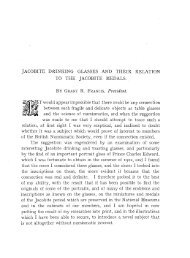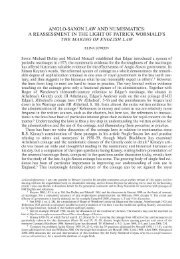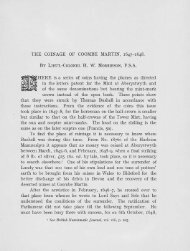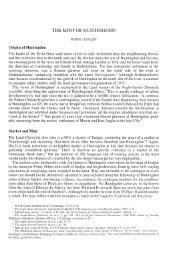a re-examination of a gold medal awarded to major rogers for ...
a re-examination of a gold medal awarded to major rogers for ...
a re-examination of a gold medal awarded to major rogers for ...
Create successful ePaper yourself
Turn your PDF publications into a flip-book with our unique Google optimized e-Paper software.
MAJOR ROGERS FOR VALOROUS SERVICES IN 1690 141<br />
the eighteenth century it may seem <strong>of</strong> little value <strong>to</strong> try <strong>to</strong> discover the silversmith<br />
<strong>re</strong>sponsible. However, a <strong>re</strong>fe<strong>re</strong>nce <strong>to</strong> Jackson's book, English Goldsmiths and Their<br />
Marks shows in the list <strong>of</strong> provincial silversmiths and jewellers <strong>re</strong>giste<strong>re</strong>d in the Books<br />
<strong>of</strong> the Company <strong>of</strong> Silversmiths in Dublin in compliance with the Acts 23 and 24 <strong>of</strong><br />
George III (I<strong>re</strong>land) the name <strong>of</strong> Charles McCalvey <strong>of</strong> Enniskillen in 1784. While the<strong>re</strong><br />
can be no pro<strong>of</strong> <strong>of</strong> this, McCalvey does meet the <strong>re</strong>qui<strong>re</strong>ments <strong>of</strong> both time and place.<br />
Reverse. Castle with flag blowing <strong>to</strong> the left. Foliage appears within the walls and is<br />
growing through the embrasu<strong>re</strong>s. Legend, THE ENNISKILLENERS.<br />
As with the obverse the first imp<strong>re</strong>ssion is <strong>of</strong> the poverty <strong>of</strong> the workmanship, even<br />
poo<strong>re</strong>r indeed than that <strong>of</strong> the obverse. This may be <strong>re</strong>adily explained by the probability<br />
that the modelling <strong>of</strong> the castle is original while the bust has been copied from another<br />
<strong>medal</strong>.<br />
The first point <strong>of</strong> inte<strong>re</strong>st is that the castle depicted is meant <strong>to</strong> <strong>re</strong>p<strong>re</strong>sent Enniskillen<br />
Castle and in all probability the Water Gate. A glance at the map will show that Enniskillen<br />
occupies a position <strong>of</strong> g<strong>re</strong>at strategical importance guarding the crossing point<br />
between Upper and Lower Lough Erne. Such a point would have been <strong>for</strong>tified at an<br />
early date and indeed in the early years <strong>of</strong> the sixteenth century a stronghold <strong>of</strong> the<br />
Magui<strong>re</strong>s was e<strong>re</strong>cted he<strong>re</strong>. In 1585 the land <strong>of</strong> I<strong>re</strong>land was divided in<strong>to</strong> Shi<strong>re</strong>s and<br />
Fermanagh was placed under a certain Sheriff Willis. The shi<strong>re</strong> was, however, only in<br />
existence on paper and could not become a <strong>re</strong>ality until the Magui<strong>re</strong> stronghold at Enniskillen<br />
was <strong>re</strong>duced. In 1594 the English troops under Captain John Dowdall s<strong>to</strong>rmed<br />
the castle by means <strong>of</strong> a trick <strong>re</strong>miniscent <strong>of</strong> the Trojan Horse. Sir William Cole, Kt.,<br />
was granted 1,000 ac<strong>re</strong>s in 1611 and in the following year he <strong>re</strong>ceived an additional 320<br />
ac<strong>re</strong>s which included 80 ac<strong>re</strong>s in the <strong>to</strong>wn <strong>of</strong> Enniskillen. As was usual in such cases he<br />
was <strong>re</strong>qui<strong>re</strong>d <strong>to</strong> e<strong>re</strong>ct a castle <strong>to</strong> protect his holding and the old castle was <strong>re</strong>pai<strong>re</strong>d.<br />
It is from this <strong>re</strong>construction that the Water Gate dates though it may contain traces <strong>of</strong><br />
the earlier Magui<strong>re</strong> stronghold. During the English Civil War, which in I<strong>re</strong>land typically<br />
<strong>to</strong>ok on a <strong>re</strong>ligious aspect, Sir William Cole held the castle as a place <strong>of</strong> <strong>re</strong>fuge <strong>for</strong><br />
Protestants from the surrounding counties and raised a <strong>re</strong>giment in 1643, which he led<br />
with considerable success in many small actions now <strong>for</strong>gotten.<br />
In the time <strong>of</strong> Sir William Cole's grandson, Sir Michael Cole, Kt., the <strong>to</strong>wn <strong>of</strong><br />
Enniskillen achieved national importance as being, with Londonderry, the only <strong>to</strong>wn<br />
in I<strong>re</strong>land <strong>to</strong> hold out <strong>for</strong> the Williamite cause. Gustavus Hamil<strong>to</strong>n was elected Governor<br />
and under his lead the citizens raised no fewer than six <strong>re</strong>giments, th<strong>re</strong>e each <strong>of</strong> horse and<br />
foot, <strong>for</strong> the defence <strong>of</strong> the <strong>to</strong>wn. Such well-trained soldiers we<strong>re</strong> welcome indeed and<br />
all six <strong>re</strong>giments we<strong>re</strong> incorporated in<strong>to</strong> the British Army, the first commissions being<br />
granted by Major-General Kirke. These six <strong>re</strong>giments we<strong>re</strong> as follows:<br />
1. Wolseley's Horse. This <strong>re</strong>giment was disbanded after the close <strong>of</strong> the campaigns in<br />
I<strong>re</strong>land and a tradition <strong>re</strong>corded by John Smet, M.D., says that from the disbanded<br />
troopers was raised the <strong>re</strong>giment that later became the 8th Royal Irish Hussars, now<br />
amalgamated with the 4th Hussars as the Queen's Royal Irish Hussars. Tradition he<strong>re</strong><br />
probably contains mo<strong>re</strong> than an element <strong>of</strong> the truth as Henry Cunningham or Conyngham,<br />
the first Colonel <strong>of</strong> the 8th Hussars was a son <strong>of</strong> the Sir Albert Conyngham who<br />
raised the <strong>re</strong>giment Conyngham's Dragoons and had served as a Captain in Forbe's<br />
Regiment <strong>of</strong> Foot, later the 18th Foot, the Royal Irish Regiment.



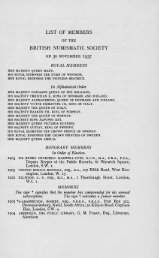

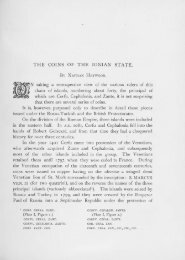
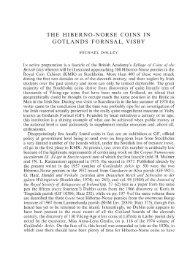
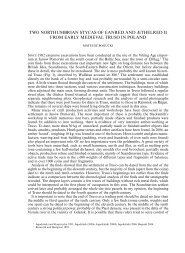

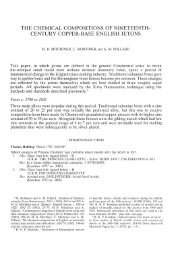
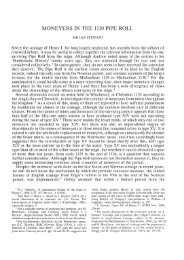
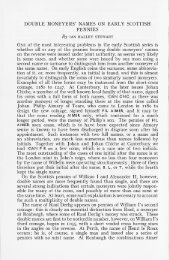
![Two Anglo-Saxon notes: [1] A Cnut die-link between the mints of ...](https://img.yumpu.com/15433998/1/189x260/two-anglo-saxon-notes-1-a-cnut-die-link-between-the-mints-of-.jpg?quality=85)
